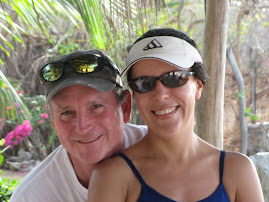
Photo left: Pancho Villa center, taken at restaurant in nearby village.
Yes, even our 2nd world neighbor (or 3rd depending where you are in Mexico) has socialized medicine. Although, the competence of the physicians is equal to US physicians, testing and treatment for those using social medicine clinics have limitations. I’ve been working at a local clinic over the last few weeks and the following is my experience and observation.

The clinic is simplistic and rudimentary. The building has no air conditioning, although some rooms have window units, they don’t run them. The 4 consultation rooms have fans or open windows and all have bad lighting. The clinic houses a one-room-four-bed hospital, a room for D&Cs, an ultrasonography room, and pharmacy. The exam tables and cabinets are old, some with rust, but functional. The doctors provide their own tools (otoscope, Doppler, etc). 1970’s typewriters are used for legible documentation and charts are in order of family last name. There are no HIPPA rules, consents to sign and individual family member’s charts are kept in one folder.

4-bed-one-room hospital for deliveries, IV rehydration, other temporary admittable ailments.
No appointments are taken so patients show up first thing in the morning and patiently wait for their name(s) to be called. The doctors see 15 to 25 patients in the morning and then break from 1-4, typical siesta time. One doctor comes in from 2-6 to cover the siesta time frame. At 4pm more patients come in and it’s basically the same process. We’re usually done with patients by 6pm. The clinic is staffed 24/7 as patients may have to be admitted at any time.

Photo right: This pressure cooker is actually their autoclave (for sterilization of equipment). They use the same type sheet paper to wrap the instruments as used for plates at taco stands.
Patients do not pay for any services or medications. One great thing about this system is all family planning contraceptive modalities are free, including condoms. They cover monthly injections, IUD, intradermal implants, OCPs and vasectomies (infrequently requested at this time). Also, all vaccines and well-child-checks are covered. Contraception is really taking off here despite the strong Catholic beliefs embedded by the Spaniards 500 years ago.

Photo left: Notes are typed out on old typewriters. Roll of TP is personal stock of doctors. In this public facility TP is a luxury.
On the flip side of family planning is the prenatal care. It’s common place to see several 15- 18 year-olds expecting their 1st, 2nd or 3rd child. However, we are seeing women in their late twenties coming in with their first pregnancy as well. All services are free and babies are delivered in the clinic hospital or cesarean in Pochutla 45 minutes away. If all goes well for vaginal deliveries, patients are sent home 5-8 hours later.
There is a fair amount of diabetes here. Unfortunately, I’ve heard Mexico has the highest per capita consumption of cola drinks – bad for the teeth and health. The testing they use is a fasting blood sugar to diagnose. They may occasionally order glucose tolerance tests but they do not use the hemoglobin A1C test which is routinely used in the US. Medications for diabetes are limited to less than 5 choices for type 2 diabetes. They do have insulin for type 1 diabetics. There are no dietitian classes and I have not seen patient education literature given. They’re told to watch their diet and take their medication and come back monthly until controlled. Kidney function is monitored by lab work and baseline ophthalmologist consults are not recommended unless there is a problem.

Treatment room, note red trash can is similar to biohazard. Osha doesn't visit Mexico.
Treatment for other common ailments such as arthritis and back pain monthly anti-inflammatory intramuscular (shot in the arm or buttocks) injections are given and x-rays ordered if strongly indicated. For psoriasis, patients are told to use creams. Their formulary does not have any cortisone creams…a must in the derm world. I recommend patients purchase cortisone creams from the private pharmacies around town, if they can afford it. Typical skin conditions are scabies, your garden variety fungal infections, lower extremity ulcers and stasis dermatitis. The clinic is treating 3 cases of leprosy I have not yet seen.
One disease absent thus far is attention deficit disorder (aka ADD) or it’s “hyperactive” cohort, ADHD. The family unit is VERY close, children work with their parents, help around the house, go to school, go to family and church events, etc. They wear school uniforms and are spic and span walking to school. There are no “nursing” or “retirement” facilities here. Families take care of their elders.

Outside conference room/kitchen. Doctora Veronica and Doctor Hugo take a break.
Private physicians are available to anyone who can pay cash the day of service. The cost of a specialist consult: dermatologist is 325 pesos and 530 for an orthopedic surgeon, 25 and 39 USDs respectively. There are private hospitals, laboratories and imaging facilities also available.
As a side note about dentistry, dental tourism is on the rise here in Mexico. An acquaintance informed us he needed serious dental work and was quoted 5800USD/tooth in the US. Here an English speaking Harvard-trained dentist will do the work for 1200USD/tooth....substantial savings.

No comments:
Post a Comment